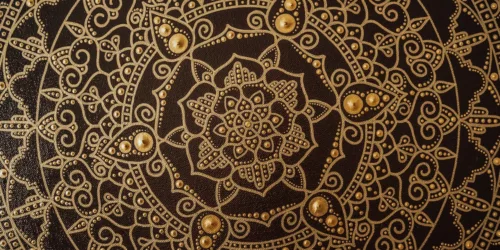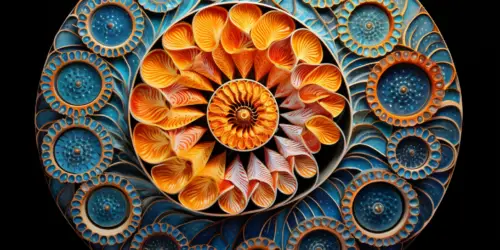The Flower of Life: Tracing the Patterns of Creation in Sacred Geometry

We’ve all heard the saying ‘there’s more to life than meets the eye,’ and when it comes to sacred geometry, this couldn’t be truer. This article dives into the world of sacred geometry by exploring the Flower of Life—a pattern that has been used in cultures around the world for centuries.
We’ll uncover its meaning, significance, and uses throughout history before understanding how we can connect with it today.
Key Takeaways
- The Flower of Life is a study of geometric patterns found in nature and their relationship to spiritual energy.
- It is an ancient practice that aims to understand how the universe works and our place within it.
- The Flower of Life represents the interconnectedness of all life and unity, and is culturally significant in many different cultures.
- By incorporating the Flower of Life into daily practice, individuals can gain insight, clarity, and make decisions aligned with their true values.
What Is Sacred Geometry
Sacred geometry is the study of geometric patterns found in nature and their relationship to spiritual energy. It’s an ancient practice that seeks to understand how the universe works and our place within it.
These geometric shapes are believed to create a connection between us and a higher power, and help us explore our free will as humans through understanding creation. Such knowledge can be used to further comprehend the divine, making it an important tool for many seeking deeper meaning.
As we explore the flower of life, we’ll gain insight into its intricate patterns and how it relates to our own spiritual journey.
Exploring the Flower of Life
We are exploring the Flower of Life, a symbol that has its origins in ancient Egypt and is believed to have been copied from the Temple of Osiris.
Its design represents the interconnectedness of all life and serves as a reminder that we are all part of a greater whole.
Culturally, it has become an important symbol for many people, representing unity, peace, and harmony.
Origins of Symbol
The Flower of Life is believed to be a symbol whose origins date back thousands of years. It has been found in many cultures, from ancient Egypt to India and China, with hidden symbolism and metaphysical implications. The main pattern consists of 19 circles, arranged in 6 concentric rings that form a flower-like structure when connected by lines. This pattern is said to represent the fundamental forms of energy found in nature and the universe itself.
| Origin | Meaning |
|---|---|
| Ancient Egypt | Creation Mythology |
| India & China | Connectedness & Oneness |
| Christianity | Holy Trinity & Unity of Souls |
| Kabbalah & Judaism | Divine Wisdom & Manifestation of God’s Will |
Meaning of Design
You can explore the deeper meaning of the Flower of Life design by looking at its various components and their connections. Its esoteric symbolism has been used for centuries, as it is said to represent the fundamental forms of space and time.
Believers in its power believe that studying this symbol helps to unlock a holistic healing process. This connection between life energies has been seen as a way to bring balance from within and without. It is believed that its geometric pattern is an expression of divine proportions, representing a roadmap back to our true selves. Thus, it serves as a reminder of our spiritual nature and encourages us to reach beyond earthly boundaries.
To understand its cultural significance, we must next examine the impact it has had throughout history.
Cultural Significance
The Flower of Life design has had a lasting cultural significance, with its symbolism being revered in various cultures across the world. Exploring intersections between science and religion, this symbol is often associated with spiritual awakenings and cosmic knowledge. In religious contexts, it is believed to represent the unity of all existence. Table 1 below outlines some of the major beliefs about this sacred geometric pattern and how they are interpreted in different cultural settings.
| Cultural Setting | Interpretation |
|---|---|
| Hinduism | Symbolizes creation itself and the divine cycle of life |
| Christianity | Symbolizes God’s power and omnipresence; associated with divine protection & blessing |
| Buddhism & Taoism | Representation of interconnectivity between all living things; belief in reincarnation; representation of yin-yang duality & balance |
The Meaning and Significance of the Flower of Life
We have explored the Flower of Life and its patterns of creation in sacred geometry, but what does it truly mean?
Its origin story is steeped in mythology, with various cultures ascribing different significances to this symbol.
Culturally, it has been used as a tool for meditation and self-reflection, representing concepts such as connectivity between all living things and cosmic consciousness.
We will now explore the meaning and significance of the Flower of Life in greater detail.
Origin Story
Y’all may not know it, but the origin story of the flower of life is steeped in sacred geometry. Its mystery origins are believed to trace back to ancient spiritual practices, with its first known appearance in antiquity around 6,000 years ago.
The symbol is thought to have originated in Egypt as a representation of the fundamental forms of space and time. It could be found inscribed on temple walls and artifacts, representing a cosmic blueprint for creation and an understanding of how we are all connected.
Over time, the Flower of Life has become a widely recognized symbol that represents unity, harmony, and interconnectedness between us all.
Cultural Relevance
You may have seen this symbol throughout history, as it has become a popular representation of unity and interconnectedness. The Flower of Life is deeply rooted in many cultures around the world, having both social and spiritual implications.
Social Impact:
- It represents a bond between individuals, communities, and generations.
- It is often used as an emblem of inclusion and acceptance.
Spiritual Connections:
- Its patterns are believed to form a blueprint for creation itself.
- It is associated with higher powers such as divine intelligence or cosmic energy.
This sacred design has been revered for centuries in different parts of the world, from ancient Middle Eastern civilizations to modern day Japan–a testament to its timeless relevance and power.
Ancient Uses of the Flower of Life
Throughout history, the Flower of Life has been used in many ancient cultures for its sacred geometry and power. Today, it is most commonly associated with Contemporary Practices such as Energy Healing.
In Ancient Egypt, the symbol was found in several temples and tombs, clearly indicating its importance to their culture. The Flower of Life is also seen on megalithic monuments from Malta like the Hypogeum of Hal-Saflieni.
In China, this symbol can be found on pottery and jade carvings that date back to the Shang Dynasty (1600 BCE – 1000 BCE). This geometric pattern has been an integral part of Hinduism since at least 500 CE when it began appearing on temple walls in India and Sri Lanka.
These examples demonstrate how widespread the use of this particular symbol was during ancient times. Transitioning into modern times, we will look at how different cultures interpret the Flower of Life today.
Interpreting the Flower of Life in Modern Times
Today, the Flower of Life is still seen and interpreted differently across various cultures around the world. From exploring philosophy to uncovering symbols, we can find ancient and modern perspectives on this powerful symbol.
Ancient:
- Beliefs that it contained the secrets of creation and held divine power
- Used as a tool to meditate on life’s mysteries
Modern:
- Interpretations that emphasize personal growth and development
- A source of inspiration for art, music, tattoos, jewelry, etc.
Connecting to the Flower of Life
Gaining a connection to the Flower of Life can be a rewarding experience that helps you unlock deeper understanding about yourself and the world. Meditation practices are key to connecting with this spiritual symbol, as it allows us to open our minds and tap into our inner wisdom.
With patience and focus, we can access its power and use it for personal growth. We can also observe how the patterns of creation are revealed through its geometry, allowing us to gain insight into how we fit into the greater universe.
Through meditation, we can learn to recognize its presence in our lives and use it as a source of guidance in making decisions or staying true to our values. By incorporating the Flower of Life into our daily practice, we can gain a heightened sense of awareness that will help us find harmony with ourselves and others.
Can Pranayama Breathing Exercises Help in Achieving a State of Meditation?
Pranayama breathing exercises benefits include aiding in achieving a state of meditation. By focusing on breath control, practitioners experience a calmer mind and reduced stress. The deep, conscious breathing techniques activate the parasympathetic nervous system, promoting relaxation and inner peace. Regular practice can enhance mindfulness, improve concentration, and create a pathway to a meditative state.
Frequently Asked Questions
What Other Patterns Exist in Sacred Geometry?
We explore other patterns in sacred geometry, such as the Vesica Piscis and Platonic Solids. Logically analyzing these shapes helps us gain a better understanding of creation. By studying their forms and ratios, we can uncover deeper truths about our universe.
How Can I Apply the Principles of the Flower of Life to My Life?
We explore the benefits and meanings of applying the principles of the Flower of Life to our lives. Meticulously analyzing its patterns, we discover a deeper connection with ourselves and nature. Logically connecting these elements leads to heightened understanding and beneficial outcomes.
Is There a Spiritual Element to the Flower of Life?
Yes, there is a spiritual element to the flower of life. Mystical connections and energy healing are often associated with this symbol, suggesting it has deeper meaning than just its physical form. We believe that through understanding this spiritual aspect, one can gain insight into their own lives.
Are There Any Other Symbols Associated With the Flower of Life?
Yes, other symbols are associated with the flower of life. These symbols have divine origins and carry meanings related to creation, energy, unity and more. Studying them helps us gain a deeper understanding of our place in the universe.
How Can I Create Artwork Based on the Flower of Life?
We are unlocking the mysteries of the flower of life, interpreting its symbols to create artwork that is therapeutic and evokes understanding. Like a puzzle needing to be solved, our meticulous analysis will reveal how this sacred geometry can be translated into art.
Conclusion
We’ve explored the flower of life, its meaning and significance, ancient uses, and how it can be interpreted in modern times.
It’s a powerful symbol that has been used to connect with deeper truths about the universe and our place within it.
As we trace the patterns of creation within this sacred geometry, we come away with an understanding that each one of us is connected to something greater than ourselves – like pieces of a larger cosmic puzzle that fit together just perfectly.





